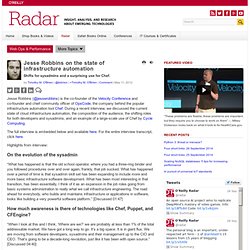

Jedi. While working on the Devops Cookbook with my fellow authors Gene Kim,John Willis,Mike Orzen we are gathering a lot of "devops" practices.

For some time we struggled with structuring them in the book. I figured we were missing a mental model to relate the practices/stories to. This blogpost is a first stab at providing a structure to codify devops practices. The wording, descriptions are pretty much work in progress, but I found them important enough to share to get your feedback. Devops in the right perspective As you probably know by now, there are many definitions of devops.
I've started reffering to : devops : collaboration,optimization across the whole organisation. As rightly pointed out by Damon Edwards , devops is not about a technology , devops is about a business problem. So even if your problem exists in dev or ops, or somewhere between, the optimization might need to be done in another part of the company. Beyond just dev and ops. Devops: what it is and why you should be doing it. This could be brogramming.

It's not devops. Devops is a big deal nowadays, and there’s a variety of ways people describe it and its benefits. Here we’ll move past the fluffy characterization involving developers and operations working together joyously—not to mention the outright wrong characterization of one superrole that does it all—and get to the heart of what devops is really about. Then we’ll go into what’s driving it, and why it’s something you should be doing. What is devops? Here’s my take, fluff-free: Devops is the push to bring the development, test, infrastructure and operations domains under software management and control. This characterization explains why developers tend to be more excited about devops than ops is. So why does everybody keep talking about dev and ops working together? First, there’s relevant technical expertise on both sides.
Now let’s see what’s driving the trend. What’s driving devops? There are a couple of major forces driving devops. Continuous delivery. Software that makes things work. Jesse Robbins on the state of infrastructure automation. Jesse Robbins (@jesserobbins) is the co-founder of the Velocity Conference and co-founder and chief community officer of OpsCode, the company behind the popular infrastructure automation tool Chef.

During a recent interview, we discussed the current state of cloud infrastructure automation, the composition of the audience, the shifting roles for both developers and sysadmins, and an example of a large-scale use of Chef by Cycle Computing. The full interview is embedded below and available here. For the entire interview transcript, click here. Highlights from interview: On the evolution of the sysadmin “What has happened is that the old school operator, where you had a three-ring binder and you followed procedures over and over again, frankly, that job sucked.
How much awareness is there of technologies like Chef, Puppet, and CFEngine? “When I look at this and I think, ‘Where are we?’ What’s the most surprising use of Chef so far? Devops. Puppet vs Chef, Fight. Titre tapageur pour faire écho à ce billet, qui compare Opscode Chef à Puppet, deux outils de gestion de parc.

Gestion de quoi ? Bon, commençons par le commencement : nous allons utiliser un petit cas concret pour illuster la chose. Supposons que vous bossez dans une grande SSII en tant que référant "intégration continue" et qu'on vous sollicite donc régulièrement pour mettre en place des forges logicielles sur projet au forfait - toute ressemblance avec une personne existante ou ayant existée, bla bla bla Option 1 : "la [bip] Pour chaque projet, fort de votre expérience, vous installez maven + jenkins + nexus + svn/git + sonar + mysql + oracleExpress + lespluginsquivontbient Comme vous êtes trop trop fort ça ne vous prend que un ou deux jours maximum pour que tout soit carré, et avec l'expérience ça doit même pouvoir se faire dans la journée - si on oublie qu'il a fallu attendre 3 mois la commande de la machine Option 2 : "la documentation exhaustive"
Puppet, Cfengine ou Chef & devops. Pour faire suite à l’article d’introduction sur le mouvement des DevOps, nous pressentons que, dans leur lourde tâche, nos héros vont devoir s’appuyer sur un certain outillage leur permettant de fluidifier la phase de Mise En Production ; qui dit fluidification dit appli déployée plus vite et le business traduit ça par : « la fonctionnalité va arriver bien plus vite au client ».

Et le business aime ça. L’utilisation du shell est une solution, mais qui montre ses limites. Il est temps de faire appel à d’autres outils. Voici un rapide tour d’horizon de quelques instruments de déploiement automatisé et de leurs principes. Les outils de type Cfengine, Puppet ou Chef reposent sur un certain nombre de concepts communs. Ces outils tendent à définir un état de configuration (système, applicative) dans lequel on souhaite voir nos machines. Les agents vont donc avoir l’incessante mission de rendre une machine conforme à une cible.